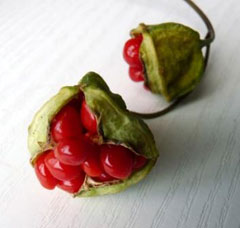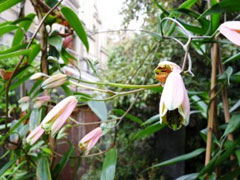 |
|
http://commons.wikimedia.org/wiki/File:Bomarea_edulis_Frucht1.jpg |
 |
| http://commons.wikimedia.org/wiki/File:Bomarea_edulis.jpg |
Translate this page:
Summary
Physical Characteristics

 Bomarea edulis is a PERENNIAL CLIMBER growing to 3 m (9ft 10in).
Bomarea edulis is a PERENNIAL CLIMBER growing to 3 m (9ft 10in).
See above for USDA hardiness. It is hardy to UK zone 8. It is in flower from August to October, and the seeds ripen in October. The species is hermaphrodite (has both male and female organs) and is pollinated by Bees.
Suitable for: light (sandy) and medium (loamy) soils and prefers well-drained soil. Suitable pH: mildly acid and neutral soils. It can grow in semi-shade (light woodland) or no shade. It prefers moist soil.
UK Hardiness Map
US Hardiness Map
Synonyms
B. hirtella. (HBK.)Herb.
Plant Habitats
Woodland Garden Sunny Edge; Dappled Shade; Shady Edge;
Edible Uses
Edible Parts: Root
Edible Uses:
Tuber - cooked[1, 22, 46, 61, 177]. When boiled the roots make a light and delicate food[2]. Rich in starch, a cream made from this farinaceous matter is wholesome and very agreeable to the taste[2].
References More on Edible Uses
Medicinal Uses
Plants For A Future can not take any responsibility for any adverse effects from the use of plants. Always seek advice from a professional before using a plant medicinally.
None known
References More on Medicinal Uses
The Bookshop: Edible Plant Books
Our Latest books on Perennial Plants For Food Forests and Permaculture Gardens in paperback or digital formats.

Edible Tropical Plants
Food Forest Plants for Hotter Conditions: 250+ Plants For Tropical Food Forests & Permaculture Gardens.
More

Edible Temperate Plants
Plants for Your Food Forest: 500 Plants for Temperate Food Forests & Permaculture Gardens.
More

More Books
PFAF have eight books available in paperback and digital formats. Browse the shop for more information.
Shop Now
Other Uses
References More on Other Uses
Cultivation details
Requires a warm sunny position and a well-drained slightly acid soil[1, 200]. Succeeds in any good soil in sun or partial shade[187]. One report says that plants are possibly hardy in the milder areas of Britain[1]. However a plant has been growing in an outdoor bed at Kew in light woodland for at least 4 years (1992) where it has flowered and produced seed in most years[K]. Another report says that it is hardy to about -10°c[187]. Plants prefer a minimum night temperature of 10°c[138]. Keep the plants almost dry in winter[138] and apply a good thick organic mulch to the roots[200]. The mulch should be removed as growth commences in the spring because the young shoots are very susceptible to slug damage[K]. The edible roots are sold in local markets in S. America[2]. The tubers should be planted about 15cm deep n the soil[233]. This genus is closely related to Alstroemeria species[200].
References Carbon Farming Information and Carbon Sequestration Information
Temperature Converter
Type a value in the Celsius field to convert the value to Fahrenheit:
Fahrenheit:
The PFAF Bookshop
Plants For A Future have a number of books available in paperback and digital form. Book titles include Edible Plants, Edible Perennials, Edible Trees,Edible Shrubs, Woodland Gardening, and Temperate Food Forest Plants. Our new book is Food Forest Plants For Hotter Conditions (Tropical and Sub-Tropical).
Shop Now
Plant Propagation
Seed - best sown as soon as it is ripe in a warm greenhouse, it will germinate in a few weeks[1]. Stratify stored seed for 3 weeks at 20°c, then 3 weeks at 5°c[138]. It usually germinates in 1 - 2 months at 20°c[138]. Prick out the seedlings into individual pots when they are large enough to handle and grow them on in the greenhouse for at least their first winter. Plant them out into their permanent positions in early summer. Division in spring, with care since the roots are brittle. Each portion must have some roots and a growth bud[1]. Pot up the divisions, grow them on in the greenhouse until they are well established and then plant them out into their permanent positions in the summer or late spring of the following year.
Other Names
If available other names are mentioned here
Native Range
Coming Soon
Weed Potential
Right plant wrong place. We are currently updating this section.
Please note that a plant may be invasive in one area but may not in your area so it's worth checking.
Conservation Status
IUCN Red List of Threatened Plants Status :

Growth: S = slow M = medium F = fast. Soil: L = light (sandy) M = medium H = heavy (clay). pH: A = acid N = neutral B = basic (alkaline). Shade: F = full shade S = semi-shade N = no shade. Moisture: D = dry M = Moist We = wet Wa = water.
Now available:
Food Forest Plants for Mediterranean Conditions
350+ Perennial Plants For Mediterranean and Drier Food Forests and Permaculture Gardens.
[Paperback and eBook]
This is the third in Plants For A Future's series of plant guides for food forests tailored to
specific climate zones. Following volumes on temperate and tropical ecosystems, this book focuses
on species suited to Mediterranean conditions—regions with hot, dry summers and cool, wet winters,
often facing the added challenge of climate change.
Read More
Expert comment
Author
(Tuss.)Herb.
Botanical References
200
Links / References
For a list of references used on this page please go here
Readers comment
| Add a comment |
|
If you have important information about this plant that may help other users please add a comment or link below. Only comments or links that are felt to be directly relevant to a plant will be included. If you think a comment/link or information contained on this page is inaccurate or misleading we would welcome your feedback at [email protected]. If you have questions about a plant please use the Forum on this website as we do not have the resources to answer questions ourselves.
* Please note: the comments by website users are not necessarily those held by PFAF and may give misleading or inaccurate information.
To leave a comment please Register or login here All comments need to be approved so will not appear immediately.
|
|